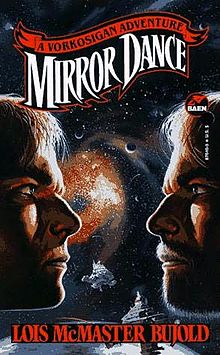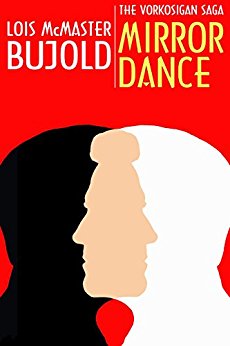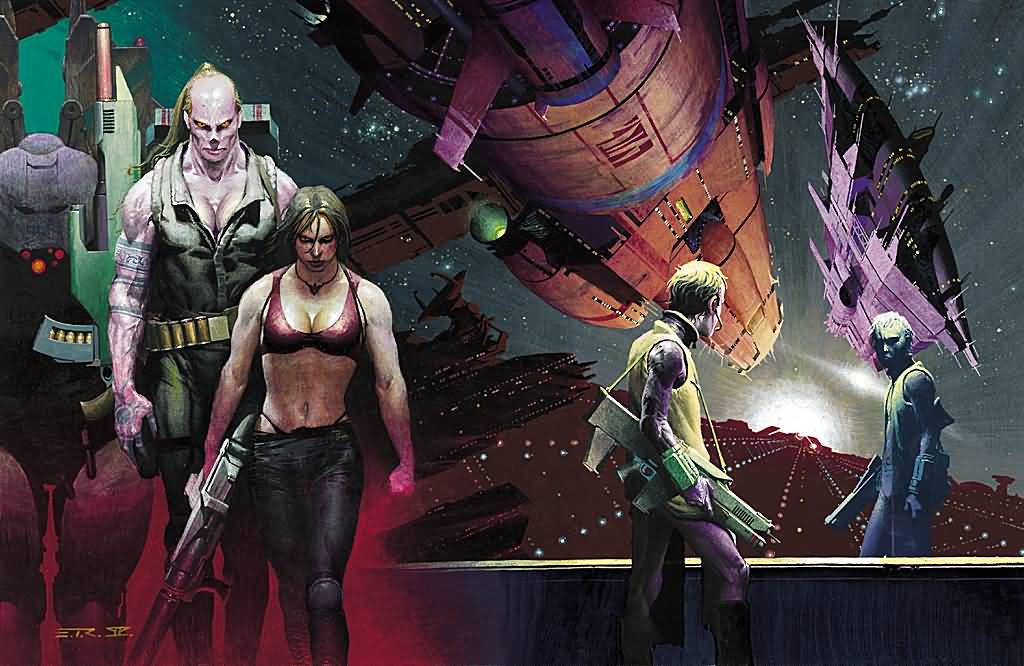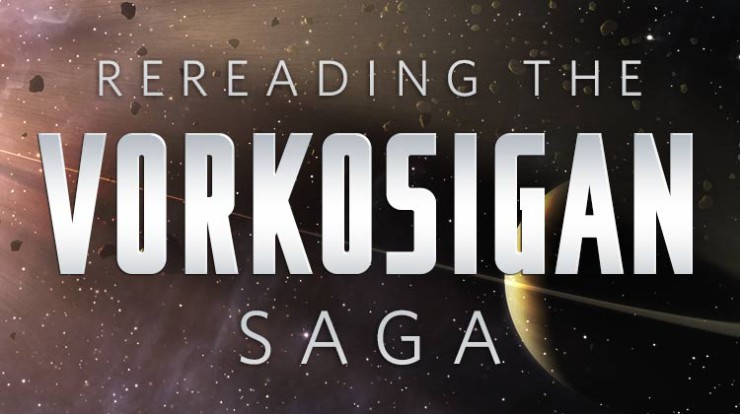I’ve read all the books in this series before, some over and over, others only once. In most cases where I’ve only read the book once, it’s because it hasn’t been convenient. I lost my copy, or it came out after A Civil Campaign and I was busy rereading that. Whether I’ve read the book one time or a thousand, I usually give it a thoughtful skim before embarking on the reread. This time, we’re flying blind because Mirror Dance is terrifying. My vague recollection is that we are about to enter the dark heart of Rudyard Kipling’s “If” – We’re about to flirt with triumph and disaster, and of the two, disaster is the far superior imposter. We’re going to be trodding the well-worn paths of “If” for a while – in Memory Miles makes one heap of all his winnings, and, as Kipling suggests, he loses it. No one is tortured by being flayed and left to itch, though, so I feel that Memory offers a more optimistic path to redemption.
We’re somewhere in the general vicinity of the halfway point of the reread, and this seems like an opportune moment for some reflection on the series so far.
[REMINDERS: This reread has an index, which you can consult if you feel like exploring previous books and chapters. Spoilers are welcome in the comments if they are relevant to the discussion at hand. Comments that question the value and dignity of individuals, or that deny anyone’s right to exist, are emphatically NOT welcome. Please take note.]
Brothers in Arms was my favorite Vorkosigan book for a long time. And it’s a great one! It’s a heroic moment for Miles, after the trauma of “Borders of Infinity.” The stakes are real, but the tone is mostly light and the story canters from crisis to crisis like Elli Quinn with a grenade launcher on her hip. It’s not as Elli-heavy as Ethan of Athos, but we do also get to spend a fair amount of time WITH Elli Quinn and the grenade launcher. There will never be a time when I don’t love this book. That said, I’ve come to a greater appreciation of some others. Right now, I’m in love with Ethan of Athos. I want to hear more about Ethan and Terrence; I want to meet their boys, and I want to know the name of their spotted pony. I’m content not to have a sequel, because I want to imagine that they’re having a lovely and uncomplicated time.
From my philosophical standpoint, Ethan and Falling Free are the most interesting books in the series so far. They have the most to say about biological reproduction and how it shapes relationships and institutions. At this point in the series, somewhere in the Galactic Nexus,
- Elli is having tons of Athosian babies, some of whom may eventually be psychic.
- Cordelia, Aral, and Jole are having a mutually satisfying adult relationship.
- Kou and Drou have had four daughters.
- Ekaterin has married Tien.
- Gregor is turning down a series of Barrayaran women.
- The Quaddies have built an empire-like thing.
All of those things are about reproduction.
The Cetagandans, who first appeared as a military menace, also turn out to be all about reproduction. The earlier books in publication order present the Cetagandans as a threat, but one that usually gets defeated. Cetaganda presented a more nuanced view of Cetagandan society and politics. Bujold periodically reveals more tiny slivers of their plans. I think there’s a lot we don’t know about the Cetagandans, and I care much more about that then I used to. Meanwhile, the Houses of Jackson’s Whole seemed, if anything, excessively commercial in their first appearance, and have become increasingly menacing as time goes on. They haven’t become less commercial; Bujold is making it clear that unchecked commerce is terrifying. We knew this in Falling Free, but the Jacksonians really like to explore the dark and shady possibilities.
Like the dark and shady possibilities available on dark and shady planets, the dark and shady characters have many ways of making themselves felt. Bothari is always with us. Emperor Ezar is less present, but I think he merits more attention. A great deal of the Vorkosigan universe is created by his decisions about how to manage his unruly son. Everything the Barrayarans name after their departed hero, every cherished/terrible folk belief, a considerable portion of Vorbarr Sultana’s urban infrastructure, and all of the political conflicts come back to Ezar. We know that Ezar loved his garden, and that he found atheism comforting, but those things are not his legacy. Ezar deserves more attention.
Although they aren’t as dark, I feel the same way about the Quaddie freedom fighters, who navigated the minefield of personhood vs. corporate property law centuries before Jackson’s Whole started cooking up clones.
To the book covers!

Mirror Dance, Baen’s first edition – This was the first of Gary Ruddell’s covers using his paired faces motif. That opposing faces drama works well here because of the book’s evocation of the evil twin thing. Mark isn’t actually an evil twin, and I appreciate that Bujold has let him be dark without being bad, because I hate the evil twin thing. There are a lot of twin-related tropes that I have strong feelings about, and I think it’s fair to let readers know that before we get too far into Mirror Dance. This is a truly appropriate cover, and I have a lot of conflicted feelings about it.

The Kindle cover shows Miles and Mark as a Venn diagram, with the overlapping space caucasian-person colored. This implies that Miles and Mark are only truly real in those aspects where they are alike, which is another twin trope that I hate. I can also see it working as a representation of Mark’s efforts to bring his split personalities into sync with each other. This interpretation makes me like it better, but the image is still several personalities short of the set.

Dear God, where do I begin? This is Esad Ribic’s cover for the Croation edition. The left-hand side—the back cover—is a devastating indictment of what it takes to sell books in Croatia. I like Ribic’s depiction of Taura—she’s massive, hulking, and paler than I had envisioned. She is also bald now. I did not know that super soldiers were prone to baldness, but then again, I can’t imagine that her creators cared. Taura’s attire is practical—there is no power in the ‘verse that can make a shirt sleeve that contains those arms. Elli strides in front of her with a large gun and no shirt. Is she stripping down after a combat operation and headed to the armory to rack her weapon before she hits the showers? Is she partially suited up for action that has yet to begin? And without criticizing Ms. Quinn’s personal choices in undergarments, I wouldn’t go for underwire and a thong if I was going to be wearing servo-assisted combat armor. I’m confident that there will not be visible panty lines, and no one’s going to be able to tell whether or not I have boobs once I’m geared up, so I’m all about comfort. Ribic painted Ivan’s orgy for the cover of Cetaganda, and Elli’s wardrobe seems in line with those priorities.
The right side—the front cover—is another world. Ribic’s Miles/Mark is wiry-thin and haunted-looking. The choice of pose evokes the Brothers in Arms scene where Miles sees Mark’s reflection in the London Underground and mistakes it for his own. It connects beautifully to the idea of reflections from the title. Miles and Mark are looking towards each other, but also beyond in separate directions, which acknowledges that they have an impact on each other without suggesting that they are reflections or echoes or parts of a whole. I would like it better if the kid was wearing pants.
That’s all for this week. I have acquired a puppy (he’s very keen to be helpful) and laid in stockpiles of therapeutic chocolate – join me next week for the opening chapters of Mirror Dance!
Ellen Cheeseman-Meyer teaches history and reads a lot.










